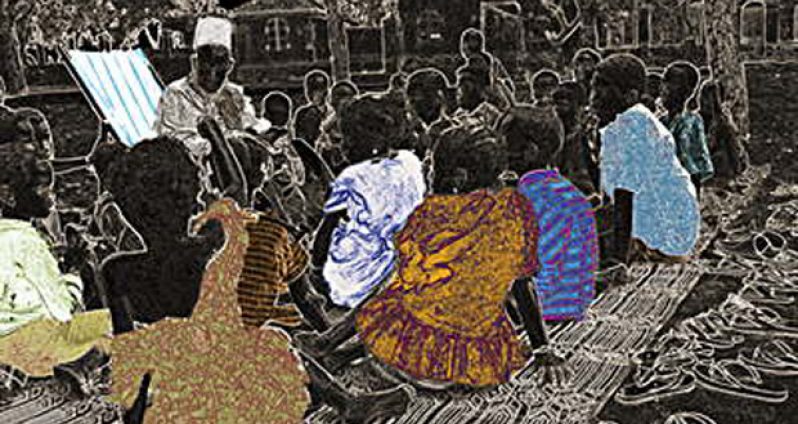By Barrington Braithwaite
WHEN Gorbachev’s Perestroika and Glasnost ended communism, what was recognised in the ensuing years by Western child entertainment providers who were invited to engage that society, was that children in Russia had lost their sense of the excitement of humour; those faculties had somehow become repressed and dormant. When I read that years ago, I attributed it to the trauma of a war of extinction waged against the Russian people in the complex scenarios of WWII. But a similar war was waged against the people of Haiti. Even worse, isolation, mass media ridicule, and economic strangulation.
IMAGINATION AT WORK
Yet, they empowered themselves and prevailed in a unique way; theirs was the application of the imagination, enveloping themselves with all its colourful attributes and cosmology.
Voodoo, with its elemental philosophy and symbolic language, allowed them to define the New World through values and the value of things in respect to themselves, and for the Haitian people that worked in their interest. Thus, as a community, they endured.
In the case of Guyana, the arrival of American TV in the late 80s with its diverse and dynamic currents of mesmerizing expressions saw cinemas that once housed the small talent shows, and were a cultural experience, being allowed to die a natural death so as to allow piracy and no directive to the local TV stations to accommodate local talents as they evolved.
How could the most profound dimension of the human consciousness be allowed to whither? Culture has been the torch bearer of the human species; the first language written in the caves across continents was written by ancient graphic artists, thereby allowing us to understand origins and geography; from the Sahara to Europe, they have summoned our attention.
INDEFENSIBLE
The indictment against the neglect of the symbolic language of culture is not defensible. The immense value of culture missed the religious community, because of the fossilised dictate that good is this way and not that, which does not apply to the myriad moods of the muses.
Yet, before the existence of the novel or published book, there was the Griot, Meistersinger, Dub Poet and what other names they are called among the nations.
Aesop, the Ethiopian, told his immortal tales, but none embodied the cultural gift of the storyteller like Jesus the Nazarene, whose challenge of the cultural status quo of the day was done with parables and poetry; parables like “Who among you that is without sin cast the first stone”, or the most profound metaphor in the Christian religion, “Neither shall they say, lo here! Or, lo there! For, behold, the Kingdom of God is within you” manifesting at the dawn of humanity through the Arts, and the eternal story of the Master, with his gift of talents to his Servants; talents that must be invested or else we betray the gift.
THE CHALLENGE
The challenge, for us, begins with the setting of the mood; the creation of the product, and the recognition of its value. These are not necessarily political challenges, but rather the task of enlightened foresight that require a corps with an agenda; an agenda that will not have, at this time, study space in our schools or activities in the communities at large to support it.
It has to be cultivated where the decline began; in the schools, where, in the late 1980s, popular music and ‘big sets’ went into the schools, and junior ‘bubble sessions’ took over the school’s year-end play, gymnastics, the costume skit, and the poetry and drama.
Back in the day, most school play costumes were made by the talented ‘Sewing Class’, now called ‘Clothing and Textiles’. Many of our theatre personalities started in the schools. We have unwittingly induced a generation to liquor and smut, not that there isn’t a time for everything, however, the timeline must constitute a balance between the tastes and temperament of the creative mind and the perennial passions of Bacchus.
I can recall the good intentions of Ganga Time’s Roy Brummell, whom I didn’t get to ‘ganga’ with on his recent short visit to ‘GT’.
When Brummell was involved in raising ‘Folk Festival’ at GBC, I was enthralled by his enthusiasm, as nothing was done on the 1st of August, [Freedom Day], and Folk Festival had favourable elements.
Then I felt his despair as Folk Festival morphed into a ‘Bubble Session’. I witnessed that decline; and when ACDA (African Cultural and Development Association) emerged, I was eager to spearhead the release of Freedom Day from GBC, and launch the now well-grounded Emancipation Day.
Today, the infrastructure is there, awakening the senses, another task in quick relative gaff, before we explore the movement that launched grassroot theatre in our age; no, I’m not talking yet about my brother, Harold Bascom or Grace Chapman. Linden at one time held the cultural torch. I’m talking about ‘Sam Chase, the people’s man from Pacoo Dam’; his padnos Jack Mellow, Lennox Greaves and Zeda Martindale.
Before we go there, to begin, we have to extract our minds from the comfort of the hard work of the creative people of other nations; learn from them ‘fuh real’, and begin to explore parallels of hard work done from our perspective.
This, the editors of our media, public and private, our law-makers, ‘dem nice folks’ in education, and we ourselves have to persevere, and not bury our talents.




.png)









